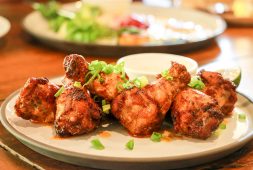Love Pumpkin Pies And Spice Lattes? This Superfood Has Awesome Benefits That Should Be Eaten In More Ways Than One

With the leaves falling and the trees turning, there is nowhere you can go without coming across something pumpkin flavored. But with all these lattes, soups and pies, people have forgotten that pumpkin is actually a fruit!
Yes, pumpkin and fruits in general, are healthy – but what kind of benefits does one actually get when you eat pumpkin? And what’s the difference between eating this stuff straight from the gourd, as compared to the canned mashed version? Here are the dietitians’ answers about this fall seasonal favorite in order for you to maximize its benefits and drink more of those warm lattes.
Nutritional information of a pumpkin:
Before anything else, let’s see the basic nutrition for one cup of cubed pumpkin, from the U.S. Department of Agriculture’s food database:
Calories: 30
Protein: 1.2 g
Carbs: 8 g
Fat: 0.1 g
Sugar: 3.2 g
Fiber: 0.6 g
Sodium: 1 mg
What health benefits can you get from eating pumpkin?
1] It boosts your vision.
Author of The Small Change Diet, Keri Gans, R.D., C.D.N., says “pumpkin is an excellent source of the antioxidant vitamin A, which is important for eye health and may slow the development of macular degeneration.” By eating a cup of pumpkin, you gain 197% of your daily recommended value for vitamin A!
2] It strengthens your immunity.
Aside from vitamin A, pumpkin is also a wonderful source of vitamin C. There is 17% of your daily recommended value in a cup of pumpkin. This helps boost your immune systemn and even lowers the risk of cancer development in the body.
3] It is good for the skin.
A carotenoid is an organic pigment that is responsible for the pumpkin’s orange color. This also acts as an antioxidant, “which help boost skin health,” says Beth Warren, R.D.N, founder of Beth Warren Nutrition and author of Secrets of a Kosher Girl.
4] It is good for the heart and stomach.
Aside from all the vitamins that the pumpkin has, it is also a good source for potassium and magnesium! These two heart-healthy minerals are good for the heart and stomach. It also offers gut-filling fiber that lowers cholesterol and regulates your bowel movements, adds Gans.
5] It is filling for less calories.
Because pumpkin is high on fiber and low on calories, this is a great alternative to add to your diet if you are looking to lose weight and eat something lighter.
The question is…. Is canned pumpkin just as healthy as eating it straight from the gourd?
Breaking down a whole pumping is time consuming, so obviously – opening a can and calling it a day is the more convenient way to go. The best part is that it’s still high in nutrition! “Both canned pumpkin and fresh pumpkin are loaded with relatively comparable vitamins and nutrients,” says Warren. Just be sure that the canned version you are purchasing is 100% made from pumpkins without any additives.
What about pumpkin seeds? Are they healthy too?
Sure they are. Scott Keatley, R.D., of Keatley Medical Nutrition Therapy says “pumpkin seeds contain zinc, which can help your immune system fight off those first colds of the fall.” An ounce of pumpkin seeds also gives you up to 10 grams of plant-based protein! They contain anti-inflammatory properties and omega-3 fatty acids, as well as other important minerals like magnesium and manganese, adds Gans.
Is pumpkin spice healthy as well?
Sorry to burst your bubble, but pumpkin spice literally has no pumpkin in it. It is usually made of other spice combinations like cinnamon, nutmeg, allspice, cloves and ginger.
Here’s a great thing though: “Spices are among the most concentrated sources of antioxidants and many other phytonutrients, so using herbs and spices is always recommended,” says co-founder of nutrition website Appetite for Health, Julie Upton, R.D. Again, be sure that the pumpkin spice you are consuming doesn’t have added sugar or additives.
After reading this whole article, you’re probably now aware that Pumpkin Spice lattes aren’t exactly a plant-based food. Yes, pumpkins are a main ingredient in fall desserts, but there are so many other things you can do with the pumpkin gourd than a pie. “Recognizing that pumpkin is not always associated with a pastry, cookie, or dessert is a nice way to re-brand the way you see pumpkin overall,” says Keatley.
He recommends grilling your pumpkin and make it a great addition to your meals. “Use this time to introduce some fall favors to your grill,” he says. You can add grilled pumpkin to your salads, wraps, or simply eat it with your favorite protein.
Gans on the other hand, is a big fan of pumpkin soup, pumpkin hummus or baked pumpkin “fries”. Try it out!



